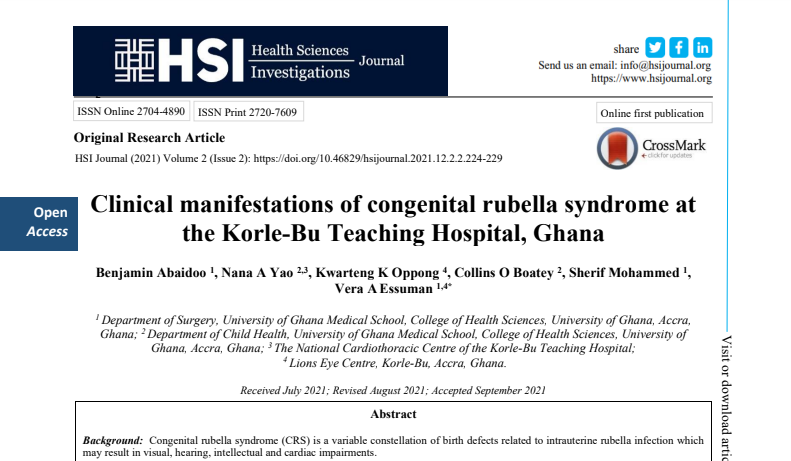Clinical Manifestations of Congenital Rubella Syndrome at the Korle-Bu Teaching Hospital, Ghana
Congenital Rubella Syndrome at the Korle-Bu Teaching Hospital, Ghana
Abstract
Introduction: Congenital rubella syndrome (CRS) is a variable constellations of birth defects related to intrauterine rubella infection which may result in visual, hearing, intellectual and cardiac impairments. The objective of this study is to describe the clinical manifestations in patients presenting with CRS at the Korle Bu Teaching Hospital using the World Health Organization criteria.
Methodology: A retrospective analysis of the medical charts of 16 children under 16 years old who presented with CRS at the Lions Eye and Cardiothoracic Centres of the Korle Bu Teaching Hospital from 2012 to 2015, was done. Ocular, cardiac and other systemic clinical and laboratory findings were documented for each patient using predesigned forms.
Results: Sixteen cases of CRS were recorded over the period (2012-2015) comprising 9 males and 7 females. The mean age at diagnosis was 6.7 months (± 6.5 months), age range at diagnosis was 1.0-24.0 months. The main ocular manifestations were; cataract 10 (62.5 %), microcornea 10 (62.5 %), microphthalmia 9 (56.3 %), nystagmus 7 (43.8 %) and strabismus 4 (25.0 %). The main cardiac defects included; patent ductus arteriosus 12 (75.0 %), pulmonary stenosis 5 (31.3 %), ventricular septal defect 5 (31.3 %), small branch pulmonary arteries 5 (31.3 %). Systemic conditions recorded includes; hearing defects 7 (43.8 %), microcephaly 7 (43.8 %), failure to thrive 5 (31.3 %) and mental retardation 2 (12.5 %).
Conclusions: Early diagnosis, high clinical vigilance for manifestations of CRS and effective surveillance and immunization programmes would help in ameliorating the effect of CRS.


